Customer Service Enhancement Project: A Report on InsCorp Insurance
VerifiedAdded on 2023/06/14
|13
|3442
|50
Report
AI Summary
This project report details an investigation into how InsCorp Insurance Company can improve its customer service and enhance stakeholder engagement. The project uses trans-disciplinary models and theories, including co-produced knowledge theories and post-normal scientific methods, to explore various data collection methods such as domain analysis, interviews, social media data, and group discussions. The report outlines the project's phases—preparation, implementation, and evaluation—and their effectiveness in identifying strategic, operational, financial, environmental, and political risks. It also highlights key skills developed during the project, such as decision-making, conflict resolution, planning, and analytical skills. The analysis evaluates the actions taken, including research methodology, data analysis methods, the phased approach, and ethical compliance. Key learnings and experiences from each week of the project are documented in a portfolio.
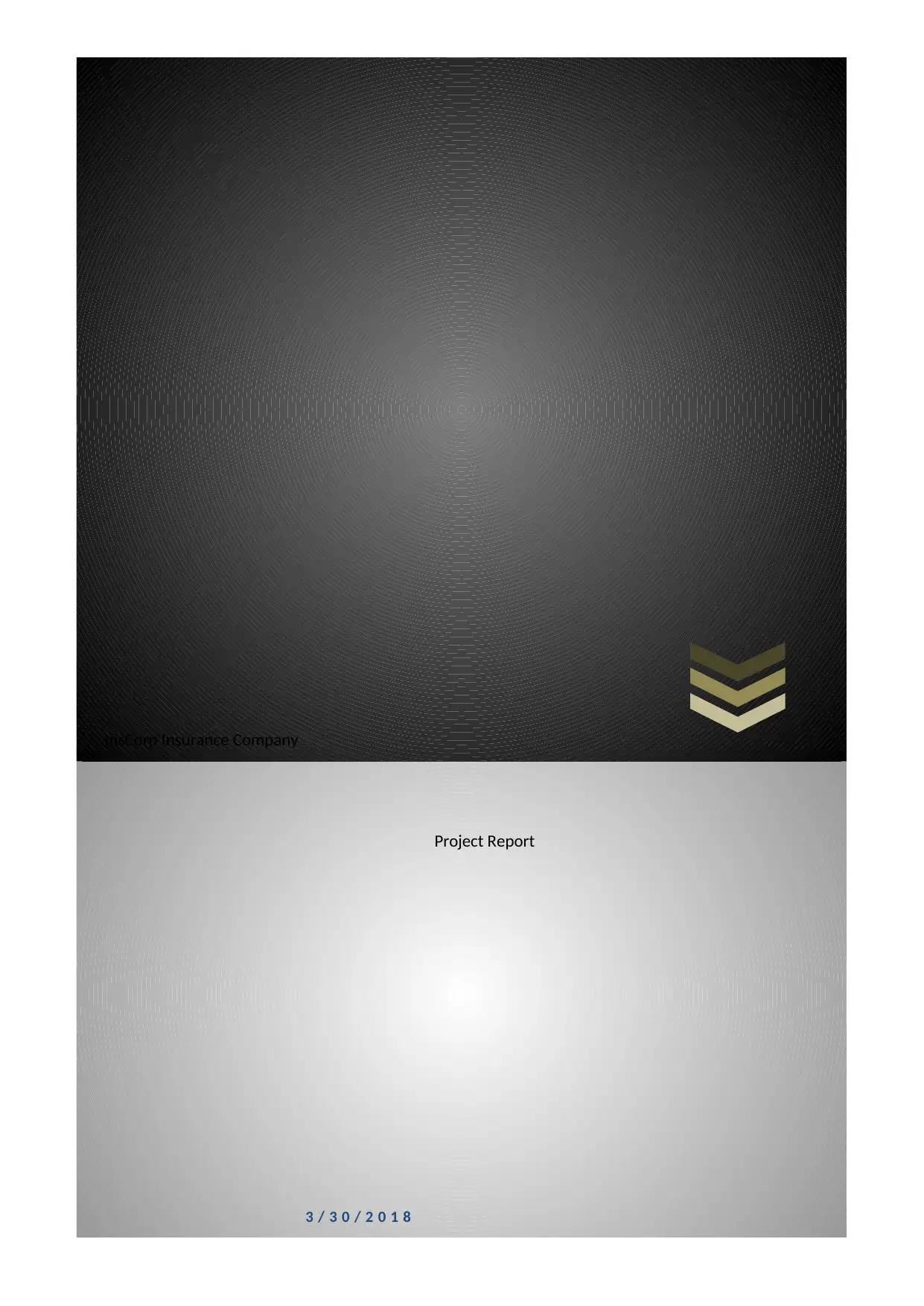
InsCorp Insurance Company
3 / 3 0 / 2 0 1 8
Project Report
3 / 3 0 / 2 0 1 8
Project Report
Paraphrase This Document
Need a fresh take? Get an instant paraphrase of this document with our AI Paraphraser
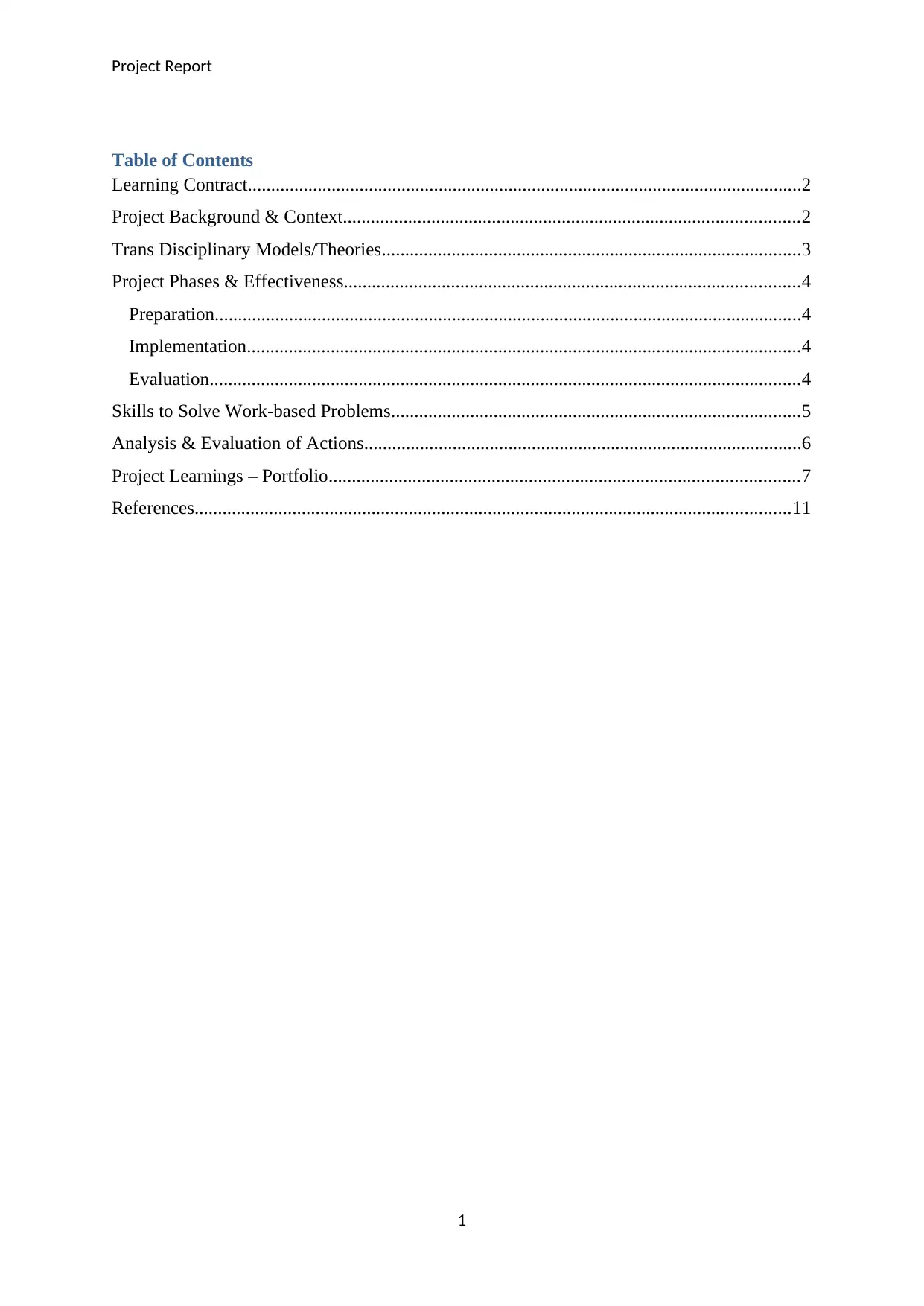
Project Report
Table of Contents
Learning Contract.......................................................................................................................2
Project Background & Context..................................................................................................2
Trans Disciplinary Models/Theories..........................................................................................3
Project Phases & Effectiveness..................................................................................................4
Preparation..............................................................................................................................4
Implementation.......................................................................................................................4
Evaluation...............................................................................................................................4
Skills to Solve Work-based Problems........................................................................................5
Analysis & Evaluation of Actions..............................................................................................6
Project Learnings – Portfolio.....................................................................................................7
References................................................................................................................................11
1
Table of Contents
Learning Contract.......................................................................................................................2
Project Background & Context..................................................................................................2
Trans Disciplinary Models/Theories..........................................................................................3
Project Phases & Effectiveness..................................................................................................4
Preparation..............................................................................................................................4
Implementation.......................................................................................................................4
Evaluation...............................................................................................................................4
Skills to Solve Work-based Problems........................................................................................5
Analysis & Evaluation of Actions..............................................................................................6
Project Learnings – Portfolio.....................................................................................................7
References................................................................................................................................11
1
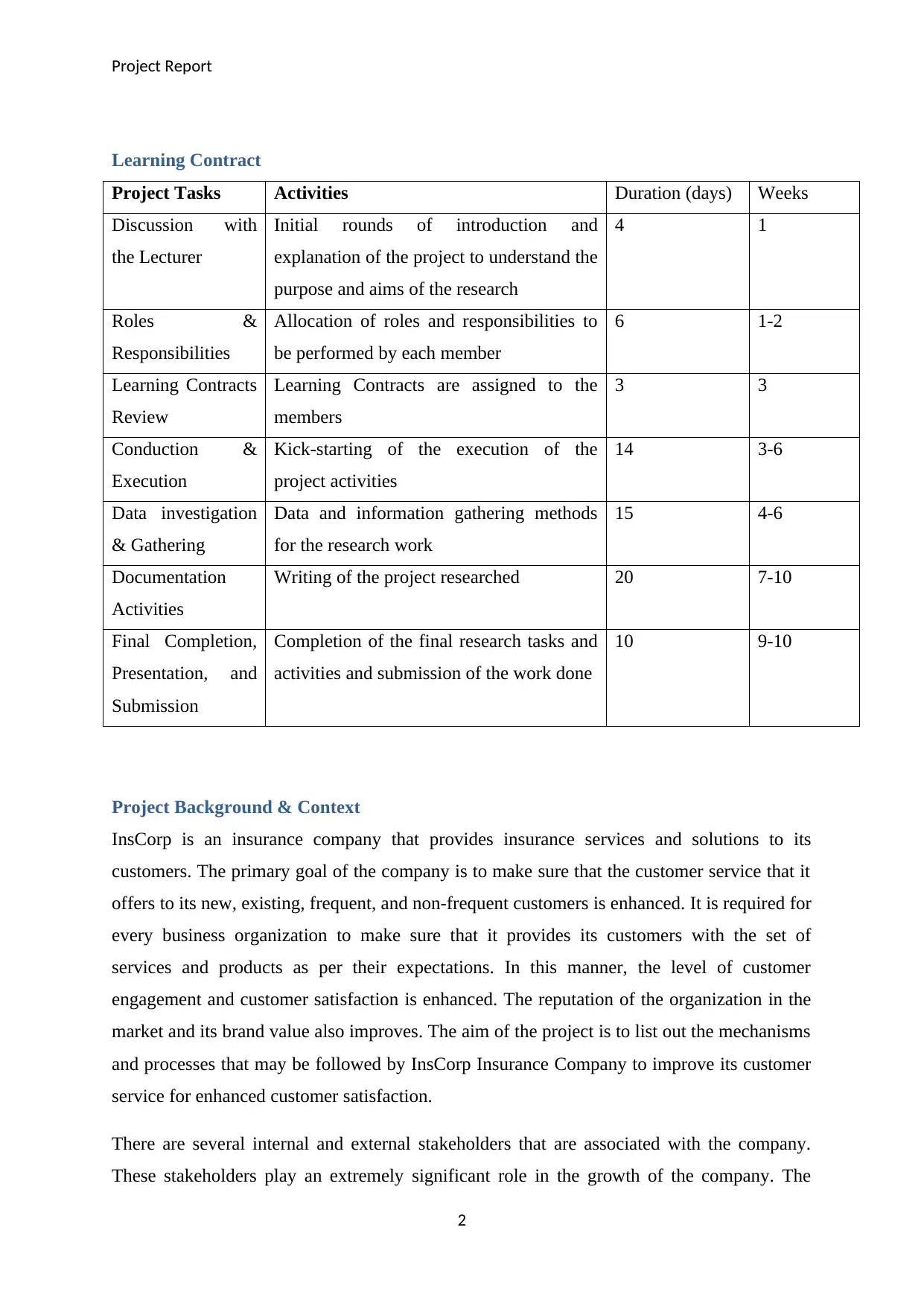
Project Report
Learning Contract
Project Tasks Activities Duration (days) Weeks
Discussion with
the Lecturer
Initial rounds of introduction and
explanation of the project to understand the
purpose and aims of the research
4 1
Roles &
Responsibilities
Allocation of roles and responsibilities to
be performed by each member
6 1-2
Learning Contracts
Review
Learning Contracts are assigned to the
members
3 3
Conduction &
Execution
Kick-starting of the execution of the
project activities
14 3-6
Data investigation
& Gathering
Data and information gathering methods
for the research work
15 4-6
Documentation
Activities
Writing of the project researched 20 7-10
Final Completion,
Presentation, and
Submission
Completion of the final research tasks and
activities and submission of the work done
10 9-10
Project Background & Context
InsCorp is an insurance company that provides insurance services and solutions to its
customers. The primary goal of the company is to make sure that the customer service that it
offers to its new, existing, frequent, and non-frequent customers is enhanced. It is required for
every business organization to make sure that it provides its customers with the set of
services and products as per their expectations. In this manner, the level of customer
engagement and customer satisfaction is enhanced. The reputation of the organization in the
market and its brand value also improves. The aim of the project is to list out the mechanisms
and processes that may be followed by InsCorp Insurance Company to improve its customer
service for enhanced customer satisfaction.
There are several internal and external stakeholders that are associated with the company.
These stakeholders play an extremely significant role in the growth of the company. The
2
Learning Contract
Project Tasks Activities Duration (days) Weeks
Discussion with
the Lecturer
Initial rounds of introduction and
explanation of the project to understand the
purpose and aims of the research
4 1
Roles &
Responsibilities
Allocation of roles and responsibilities to
be performed by each member
6 1-2
Learning Contracts
Review
Learning Contracts are assigned to the
members
3 3
Conduction &
Execution
Kick-starting of the execution of the
project activities
14 3-6
Data investigation
& Gathering
Data and information gathering methods
for the research work
15 4-6
Documentation
Activities
Writing of the project researched 20 7-10
Final Completion,
Presentation, and
Submission
Completion of the final research tasks and
activities and submission of the work done
10 9-10
Project Background & Context
InsCorp is an insurance company that provides insurance services and solutions to its
customers. The primary goal of the company is to make sure that the customer service that it
offers to its new, existing, frequent, and non-frequent customers is enhanced. It is required for
every business organization to make sure that it provides its customers with the set of
services and products as per their expectations. In this manner, the level of customer
engagement and customer satisfaction is enhanced. The reputation of the organization in the
market and its brand value also improves. The aim of the project is to list out the mechanisms
and processes that may be followed by InsCorp Insurance Company to improve its customer
service for enhanced customer satisfaction.
There are several internal and external stakeholders that are associated with the company.
These stakeholders play an extremely significant role in the growth of the company. The
2
⊘ This is a preview!⊘
Do you want full access?
Subscribe today to unlock all pages.

Trusted by 1+ million students worldwide
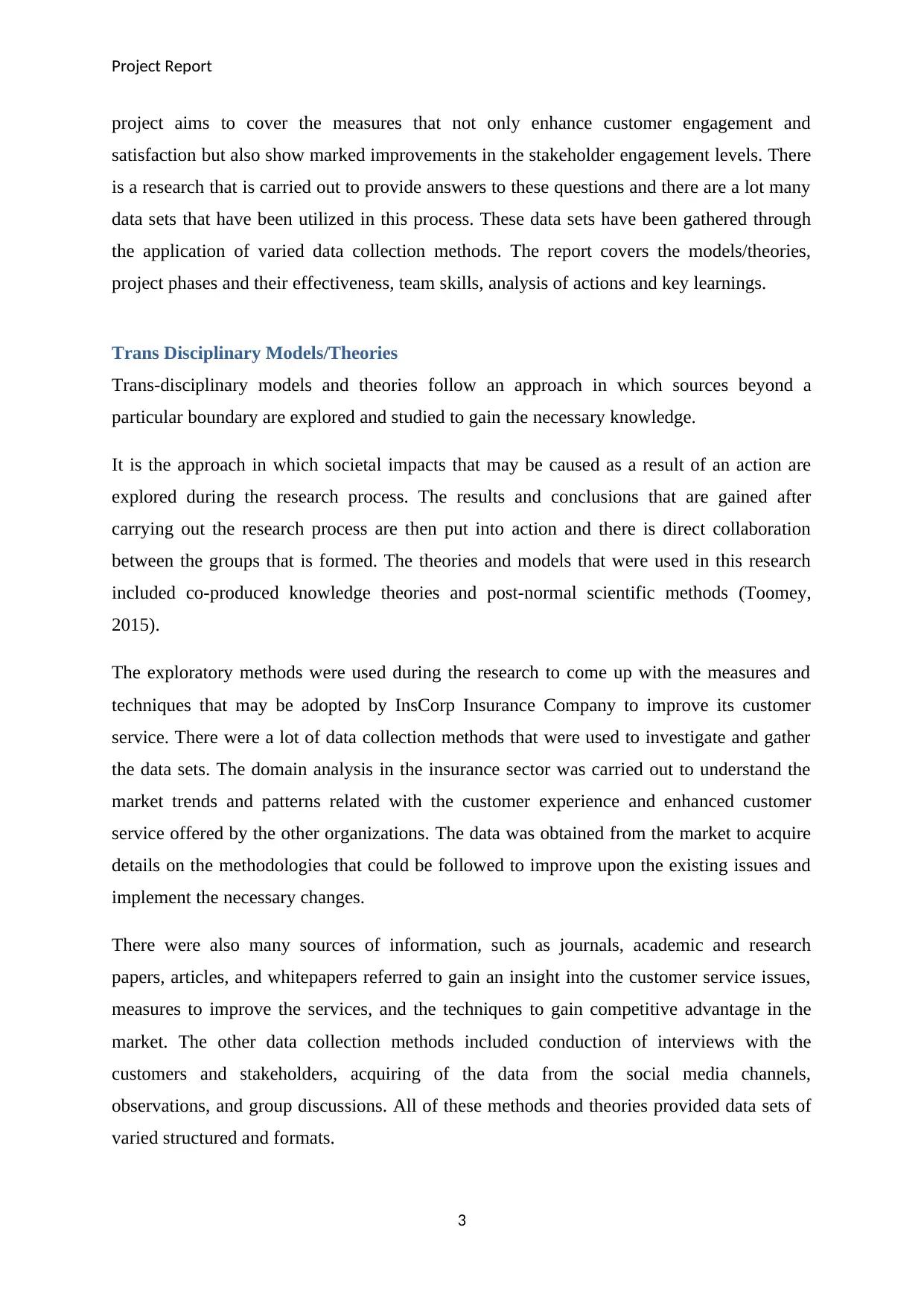
Project Report
project aims to cover the measures that not only enhance customer engagement and
satisfaction but also show marked improvements in the stakeholder engagement levels. There
is a research that is carried out to provide answers to these questions and there are a lot many
data sets that have been utilized in this process. These data sets have been gathered through
the application of varied data collection methods. The report covers the models/theories,
project phases and their effectiveness, team skills, analysis of actions and key learnings.
Trans Disciplinary Models/Theories
Trans-disciplinary models and theories follow an approach in which sources beyond a
particular boundary are explored and studied to gain the necessary knowledge.
It is the approach in which societal impacts that may be caused as a result of an action are
explored during the research process. The results and conclusions that are gained after
carrying out the research process are then put into action and there is direct collaboration
between the groups that is formed. The theories and models that were used in this research
included co-produced knowledge theories and post-normal scientific methods (Toomey,
2015).
The exploratory methods were used during the research to come up with the measures and
techniques that may be adopted by InsCorp Insurance Company to improve its customer
service. There were a lot of data collection methods that were used to investigate and gather
the data sets. The domain analysis in the insurance sector was carried out to understand the
market trends and patterns related with the customer experience and enhanced customer
service offered by the other organizations. The data was obtained from the market to acquire
details on the methodologies that could be followed to improve upon the existing issues and
implement the necessary changes.
There were also many sources of information, such as journals, academic and research
papers, articles, and whitepapers referred to gain an insight into the customer service issues,
measures to improve the services, and the techniques to gain competitive advantage in the
market. The other data collection methods included conduction of interviews with the
customers and stakeholders, acquiring of the data from the social media channels,
observations, and group discussions. All of these methods and theories provided data sets of
varied structured and formats.
3
project aims to cover the measures that not only enhance customer engagement and
satisfaction but also show marked improvements in the stakeholder engagement levels. There
is a research that is carried out to provide answers to these questions and there are a lot many
data sets that have been utilized in this process. These data sets have been gathered through
the application of varied data collection methods. The report covers the models/theories,
project phases and their effectiveness, team skills, analysis of actions and key learnings.
Trans Disciplinary Models/Theories
Trans-disciplinary models and theories follow an approach in which sources beyond a
particular boundary are explored and studied to gain the necessary knowledge.
It is the approach in which societal impacts that may be caused as a result of an action are
explored during the research process. The results and conclusions that are gained after
carrying out the research process are then put into action and there is direct collaboration
between the groups that is formed. The theories and models that were used in this research
included co-produced knowledge theories and post-normal scientific methods (Toomey,
2015).
The exploratory methods were used during the research to come up with the measures and
techniques that may be adopted by InsCorp Insurance Company to improve its customer
service. There were a lot of data collection methods that were used to investigate and gather
the data sets. The domain analysis in the insurance sector was carried out to understand the
market trends and patterns related with the customer experience and enhanced customer
service offered by the other organizations. The data was obtained from the market to acquire
details on the methodologies that could be followed to improve upon the existing issues and
implement the necessary changes.
There were also many sources of information, such as journals, academic and research
papers, articles, and whitepapers referred to gain an insight into the customer service issues,
measures to improve the services, and the techniques to gain competitive advantage in the
market. The other data collection methods included conduction of interviews with the
customers and stakeholders, acquiring of the data from the social media channels,
observations, and group discussions. All of these methods and theories provided data sets of
varied structured and formats.
3
Paraphrase This Document
Need a fresh take? Get an instant paraphrase of this document with our AI Paraphraser
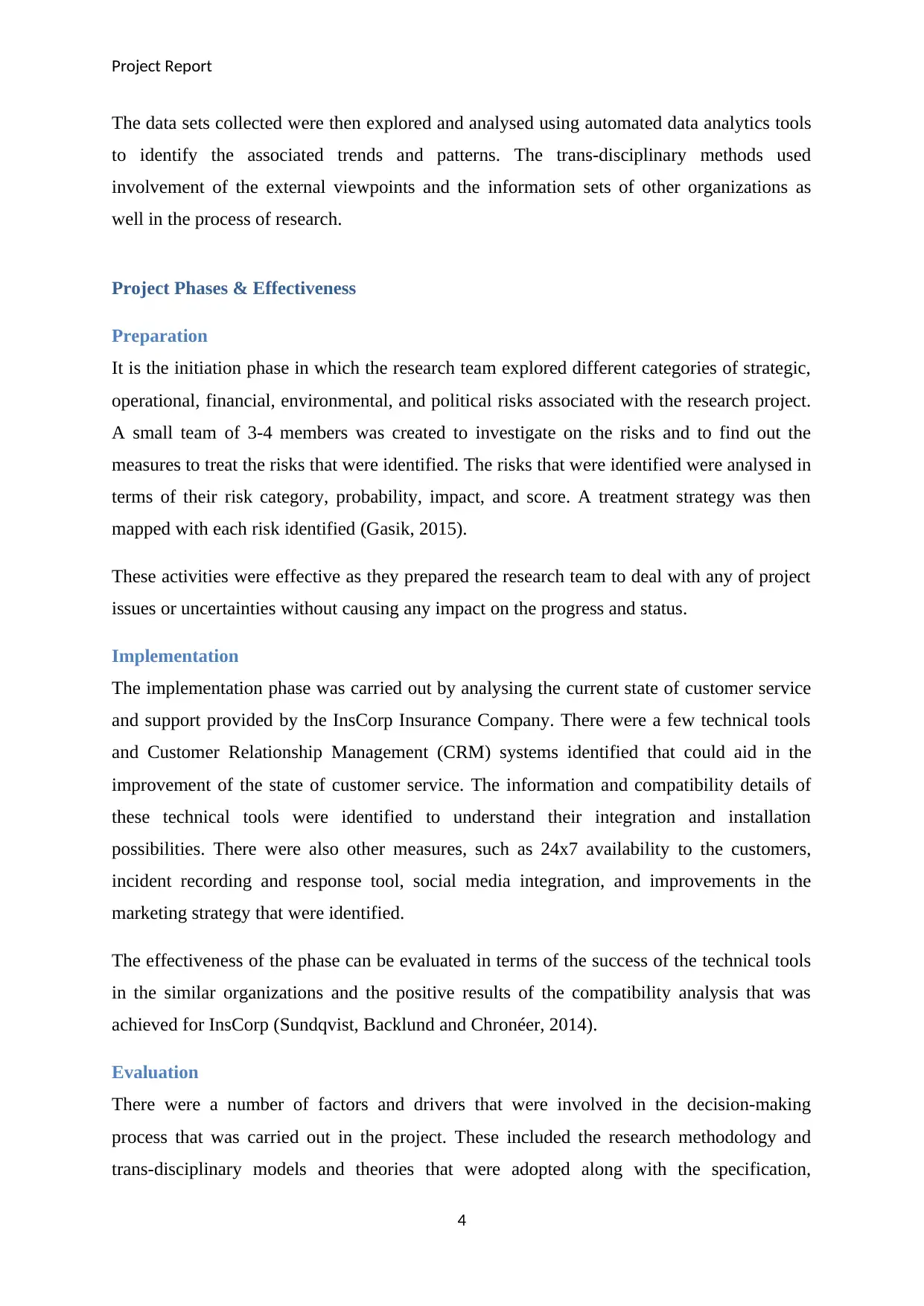
Project Report
The data sets collected were then explored and analysed using automated data analytics tools
to identify the associated trends and patterns. The trans-disciplinary methods used
involvement of the external viewpoints and the information sets of other organizations as
well in the process of research.
Project Phases & Effectiveness
Preparation
It is the initiation phase in which the research team explored different categories of strategic,
operational, financial, environmental, and political risks associated with the research project.
A small team of 3-4 members was created to investigate on the risks and to find out the
measures to treat the risks that were identified. The risks that were identified were analysed in
terms of their risk category, probability, impact, and score. A treatment strategy was then
mapped with each risk identified (Gasik, 2015).
These activities were effective as they prepared the research team to deal with any of project
issues or uncertainties without causing any impact on the progress and status.
Implementation
The implementation phase was carried out by analysing the current state of customer service
and support provided by the InsCorp Insurance Company. There were a few technical tools
and Customer Relationship Management (CRM) systems identified that could aid in the
improvement of the state of customer service. The information and compatibility details of
these technical tools were identified to understand their integration and installation
possibilities. There were also other measures, such as 24x7 availability to the customers,
incident recording and response tool, social media integration, and improvements in the
marketing strategy that were identified.
The effectiveness of the phase can be evaluated in terms of the success of the technical tools
in the similar organizations and the positive results of the compatibility analysis that was
achieved for InsCorp (Sundqvist, Backlund and Chronéer, 2014).
Evaluation
There were a number of factors and drivers that were involved in the decision-making
process that was carried out in the project. These included the research methodology and
trans-disciplinary models and theories that were adopted along with the specification,
4
The data sets collected were then explored and analysed using automated data analytics tools
to identify the associated trends and patterns. The trans-disciplinary methods used
involvement of the external viewpoints and the information sets of other organizations as
well in the process of research.
Project Phases & Effectiveness
Preparation
It is the initiation phase in which the research team explored different categories of strategic,
operational, financial, environmental, and political risks associated with the research project.
A small team of 3-4 members was created to investigate on the risks and to find out the
measures to treat the risks that were identified. The risks that were identified were analysed in
terms of their risk category, probability, impact, and score. A treatment strategy was then
mapped with each risk identified (Gasik, 2015).
These activities were effective as they prepared the research team to deal with any of project
issues or uncertainties without causing any impact on the progress and status.
Implementation
The implementation phase was carried out by analysing the current state of customer service
and support provided by the InsCorp Insurance Company. There were a few technical tools
and Customer Relationship Management (CRM) systems identified that could aid in the
improvement of the state of customer service. The information and compatibility details of
these technical tools were identified to understand their integration and installation
possibilities. There were also other measures, such as 24x7 availability to the customers,
incident recording and response tool, social media integration, and improvements in the
marketing strategy that were identified.
The effectiveness of the phase can be evaluated in terms of the success of the technical tools
in the similar organizations and the positive results of the compatibility analysis that was
achieved for InsCorp (Sundqvist, Backlund and Chronéer, 2014).
Evaluation
There were a number of factors and drivers that were involved in the decision-making
process that was carried out in the project. These included the research methodology and
trans-disciplinary models and theories that were adopted along with the specification,
4
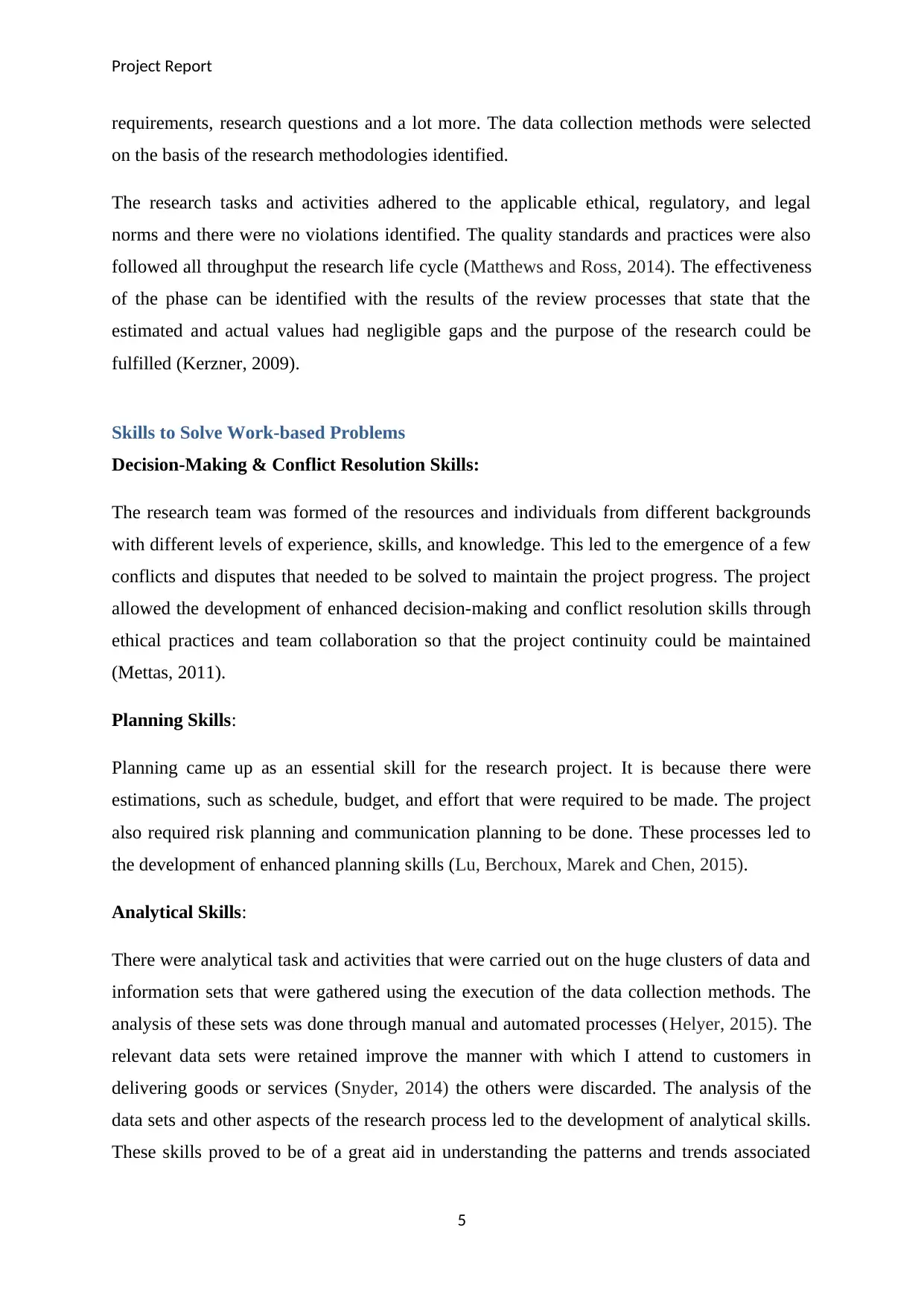
Project Report
requirements, research questions and a lot more. The data collection methods were selected
on the basis of the research methodologies identified.
The research tasks and activities adhered to the applicable ethical, regulatory, and legal
norms and there were no violations identified. The quality standards and practices were also
followed all throughput the research life cycle (Matthews and Ross, 2014). The effectiveness
of the phase can be identified with the results of the review processes that state that the
estimated and actual values had negligible gaps and the purpose of the research could be
fulfilled (Kerzner, 2009).
Skills to Solve Work-based Problems
Decision-Making & Conflict Resolution Skills:
The research team was formed of the resources and individuals from different backgrounds
with different levels of experience, skills, and knowledge. This led to the emergence of a few
conflicts and disputes that needed to be solved to maintain the project progress. The project
allowed the development of enhanced decision-making and conflict resolution skills through
ethical practices and team collaboration so that the project continuity could be maintained
(Mettas, 2011).
Planning Skills:
Planning came up as an essential skill for the research project. It is because there were
estimations, such as schedule, budget, and effort that were required to be made. The project
also required risk planning and communication planning to be done. These processes led to
the development of enhanced planning skills (Lu, Berchoux, Marek and Chen, 2015).
Analytical Skills:
There were analytical task and activities that were carried out on the huge clusters of data and
information sets that were gathered using the execution of the data collection methods. The
analysis of these sets was done through manual and automated processes (Helyer, 2015). The
relevant data sets were retained improve the manner with which I attend to customers in
delivering goods or services (Snyder, 2014) the others were discarded. The analysis of the
data sets and other aspects of the research process led to the development of analytical skills.
These skills proved to be of a great aid in understanding the patterns and trends associated
5
requirements, research questions and a lot more. The data collection methods were selected
on the basis of the research methodologies identified.
The research tasks and activities adhered to the applicable ethical, regulatory, and legal
norms and there were no violations identified. The quality standards and practices were also
followed all throughput the research life cycle (Matthews and Ross, 2014). The effectiveness
of the phase can be identified with the results of the review processes that state that the
estimated and actual values had negligible gaps and the purpose of the research could be
fulfilled (Kerzner, 2009).
Skills to Solve Work-based Problems
Decision-Making & Conflict Resolution Skills:
The research team was formed of the resources and individuals from different backgrounds
with different levels of experience, skills, and knowledge. This led to the emergence of a few
conflicts and disputes that needed to be solved to maintain the project progress. The project
allowed the development of enhanced decision-making and conflict resolution skills through
ethical practices and team collaboration so that the project continuity could be maintained
(Mettas, 2011).
Planning Skills:
Planning came up as an essential skill for the research project. It is because there were
estimations, such as schedule, budget, and effort that were required to be made. The project
also required risk planning and communication planning to be done. These processes led to
the development of enhanced planning skills (Lu, Berchoux, Marek and Chen, 2015).
Analytical Skills:
There were analytical task and activities that were carried out on the huge clusters of data and
information sets that were gathered using the execution of the data collection methods. The
analysis of these sets was done through manual and automated processes (Helyer, 2015). The
relevant data sets were retained improve the manner with which I attend to customers in
delivering goods or services (Snyder, 2014) the others were discarded. The analysis of the
data sets and other aspects of the research process led to the development of analytical skills.
These skills proved to be of a great aid in understanding the patterns and trends associated
5
⊘ This is a preview!⊘
Do you want full access?
Subscribe today to unlock all pages.

Trusted by 1+ million students worldwide
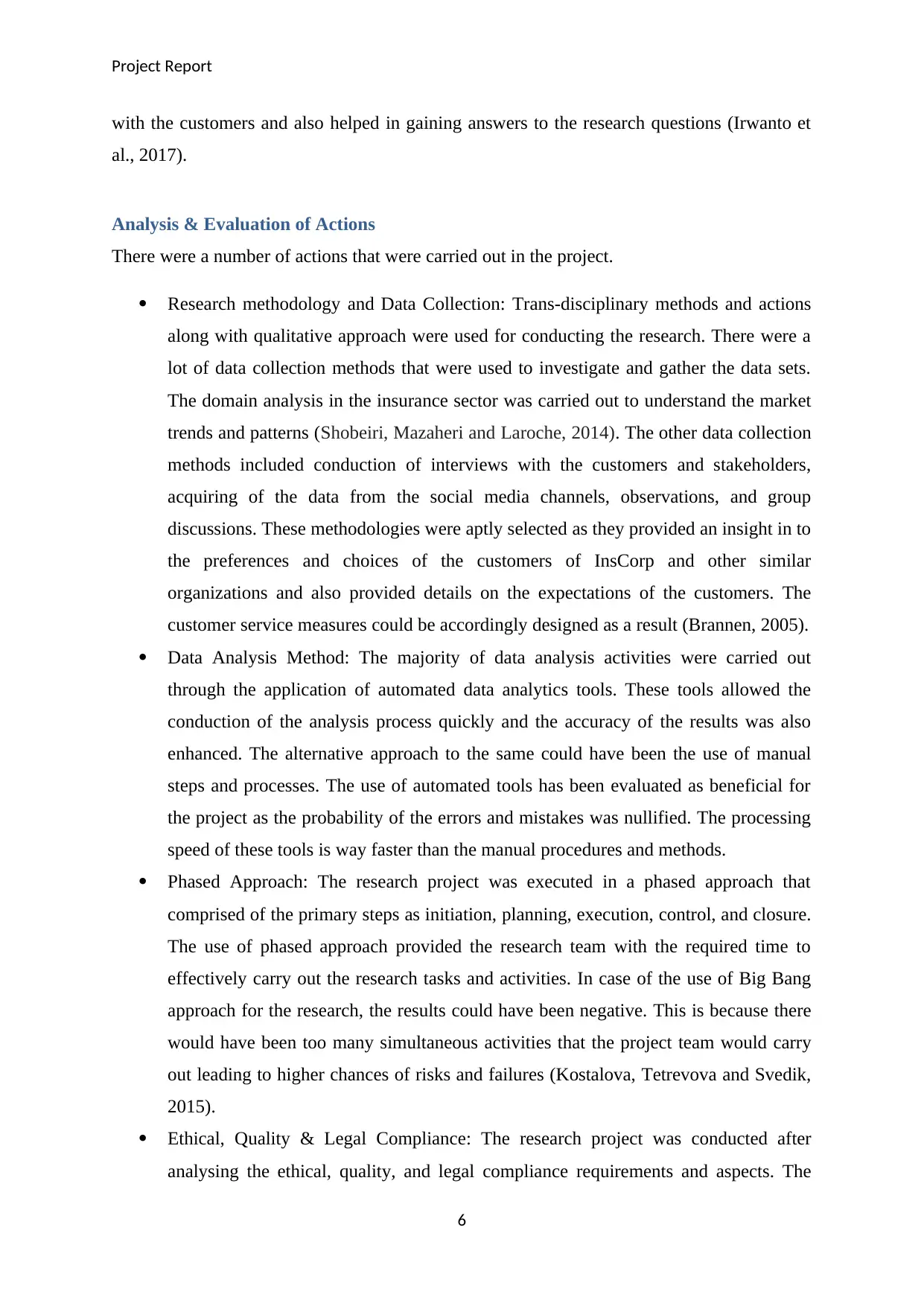
Project Report
with the customers and also helped in gaining answers to the research questions (Irwanto et
al., 2017).
Analysis & Evaluation of Actions
There were a number of actions that were carried out in the project.
Research methodology and Data Collection: Trans-disciplinary methods and actions
along with qualitative approach were used for conducting the research. There were a
lot of data collection methods that were used to investigate and gather the data sets.
The domain analysis in the insurance sector was carried out to understand the market
trends and patterns (Shobeiri, Mazaheri and Laroche, 2014). The other data collection
methods included conduction of interviews with the customers and stakeholders,
acquiring of the data from the social media channels, observations, and group
discussions. These methodologies were aptly selected as they provided an insight in to
the preferences and choices of the customers of InsCorp and other similar
organizations and also provided details on the expectations of the customers. The
customer service measures could be accordingly designed as a result (Brannen, 2005).
Data Analysis Method: The majority of data analysis activities were carried out
through the application of automated data analytics tools. These tools allowed the
conduction of the analysis process quickly and the accuracy of the results was also
enhanced. The alternative approach to the same could have been the use of manual
steps and processes. The use of automated tools has been evaluated as beneficial for
the project as the probability of the errors and mistakes was nullified. The processing
speed of these tools is way faster than the manual procedures and methods.
Phased Approach: The research project was executed in a phased approach that
comprised of the primary steps as initiation, planning, execution, control, and closure.
The use of phased approach provided the research team with the required time to
effectively carry out the research tasks and activities. In case of the use of Big Bang
approach for the research, the results could have been negative. This is because there
would have been too many simultaneous activities that the project team would carry
out leading to higher chances of risks and failures (Kostalova, Tetrevova and Svedik,
2015).
Ethical, Quality & Legal Compliance: The research project was conducted after
analysing the ethical, quality, and legal compliance requirements and aspects. The
6
with the customers and also helped in gaining answers to the research questions (Irwanto et
al., 2017).
Analysis & Evaluation of Actions
There were a number of actions that were carried out in the project.
Research methodology and Data Collection: Trans-disciplinary methods and actions
along with qualitative approach were used for conducting the research. There were a
lot of data collection methods that were used to investigate and gather the data sets.
The domain analysis in the insurance sector was carried out to understand the market
trends and patterns (Shobeiri, Mazaheri and Laroche, 2014). The other data collection
methods included conduction of interviews with the customers and stakeholders,
acquiring of the data from the social media channels, observations, and group
discussions. These methodologies were aptly selected as they provided an insight in to
the preferences and choices of the customers of InsCorp and other similar
organizations and also provided details on the expectations of the customers. The
customer service measures could be accordingly designed as a result (Brannen, 2005).
Data Analysis Method: The majority of data analysis activities were carried out
through the application of automated data analytics tools. These tools allowed the
conduction of the analysis process quickly and the accuracy of the results was also
enhanced. The alternative approach to the same could have been the use of manual
steps and processes. The use of automated tools has been evaluated as beneficial for
the project as the probability of the errors and mistakes was nullified. The processing
speed of these tools is way faster than the manual procedures and methods.
Phased Approach: The research project was executed in a phased approach that
comprised of the primary steps as initiation, planning, execution, control, and closure.
The use of phased approach provided the research team with the required time to
effectively carry out the research tasks and activities. In case of the use of Big Bang
approach for the research, the results could have been negative. This is because there
would have been too many simultaneous activities that the project team would carry
out leading to higher chances of risks and failures (Kostalova, Tetrevova and Svedik,
2015).
Ethical, Quality & Legal Compliance: The research project was conducted after
analysing the ethical, quality, and legal compliance requirements and aspects. The
6
Paraphrase This Document
Need a fresh take? Get an instant paraphrase of this document with our AI Paraphraser
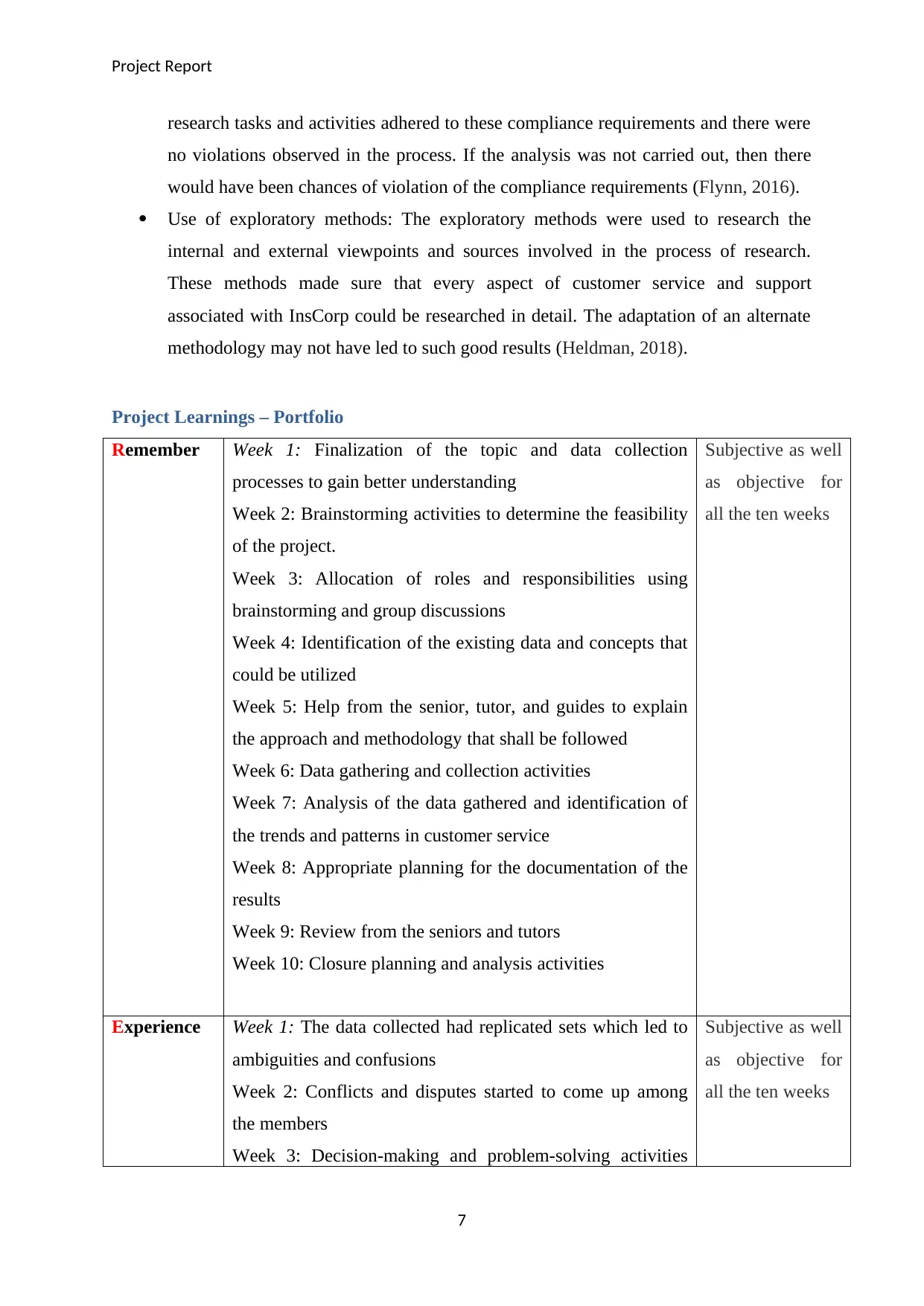
Project Report
research tasks and activities adhered to these compliance requirements and there were
no violations observed in the process. If the analysis was not carried out, then there
would have been chances of violation of the compliance requirements (Flynn, 2016).
Use of exploratory methods: The exploratory methods were used to research the
internal and external viewpoints and sources involved in the process of research.
These methods made sure that every aspect of customer service and support
associated with InsCorp could be researched in detail. The adaptation of an alternate
methodology may not have led to such good results (Heldman, 2018).
Project Learnings – Portfolio
Remember Week 1: Finalization of the topic and data collection
processes to gain better understanding
Week 2: Brainstorming activities to determine the feasibility
of the project.
Week 3: Allocation of roles and responsibilities using
brainstorming and group discussions
Week 4: Identification of the existing data and concepts that
could be utilized
Week 5: Help from the senior, tutor, and guides to explain
the approach and methodology that shall be followed
Week 6: Data gathering and collection activities
Week 7: Analysis of the data gathered and identification of
the trends and patterns in customer service
Week 8: Appropriate planning for the documentation of the
results
Week 9: Review from the seniors and tutors
Week 10: Closure planning and analysis activities
Subjective as well
as objective for
all the ten weeks
Experience Week 1: The data collected had replicated sets which led to
ambiguities and confusions
Week 2: Conflicts and disputes started to come up among
the members
Week 3: Decision-making and problem-solving activities
Subjective as well
as objective for
all the ten weeks
7
research tasks and activities adhered to these compliance requirements and there were
no violations observed in the process. If the analysis was not carried out, then there
would have been chances of violation of the compliance requirements (Flynn, 2016).
Use of exploratory methods: The exploratory methods were used to research the
internal and external viewpoints and sources involved in the process of research.
These methods made sure that every aspect of customer service and support
associated with InsCorp could be researched in detail. The adaptation of an alternate
methodology may not have led to such good results (Heldman, 2018).
Project Learnings – Portfolio
Remember Week 1: Finalization of the topic and data collection
processes to gain better understanding
Week 2: Brainstorming activities to determine the feasibility
of the project.
Week 3: Allocation of roles and responsibilities using
brainstorming and group discussions
Week 4: Identification of the existing data and concepts that
could be utilized
Week 5: Help from the senior, tutor, and guides to explain
the approach and methodology that shall be followed
Week 6: Data gathering and collection activities
Week 7: Analysis of the data gathered and identification of
the trends and patterns in customer service
Week 8: Appropriate planning for the documentation of the
results
Week 9: Review from the seniors and tutors
Week 10: Closure planning and analysis activities
Subjective as well
as objective for
all the ten weeks
Experience Week 1: The data collected had replicated sets which led to
ambiguities and confusions
Week 2: Conflicts and disputes started to come up among
the members
Week 3: Decision-making and problem-solving activities
Subjective as well
as objective for
all the ten weeks
7
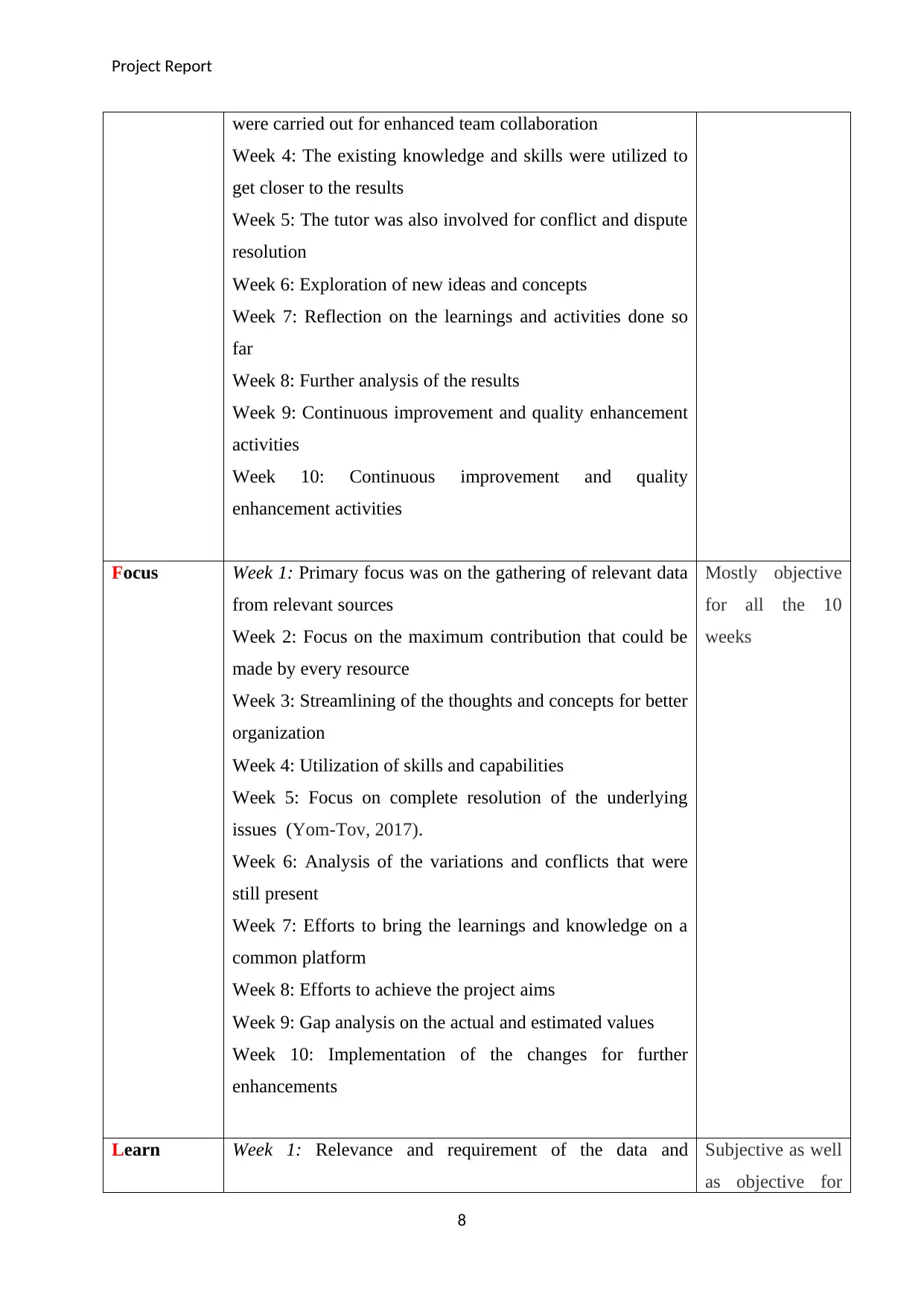
Project Report
were carried out for enhanced team collaboration
Week 4: The existing knowledge and skills were utilized to
get closer to the results
Week 5: The tutor was also involved for conflict and dispute
resolution
Week 6: Exploration of new ideas and concepts
Week 7: Reflection on the learnings and activities done so
far
Week 8: Further analysis of the results
Week 9: Continuous improvement and quality enhancement
activities
Week 10: Continuous improvement and quality
enhancement activities
Focus Week 1: Primary focus was on the gathering of relevant data
from relevant sources
Week 2: Focus on the maximum contribution that could be
made by every resource
Week 3: Streamlining of the thoughts and concepts for better
organization
Week 4: Utilization of skills and capabilities
Week 5: Focus on complete resolution of the underlying
issues (Yom-Tov, 2017).
Week 6: Analysis of the variations and conflicts that were
still present
Week 7: Efforts to bring the learnings and knowledge on a
common platform
Week 8: Efforts to achieve the project aims
Week 9: Gap analysis on the actual and estimated values
Week 10: Implementation of the changes for further
enhancements
Mostly objective
for all the 10
weeks
Learn Week 1: Relevance and requirement of the data and Subjective as well
as objective for
8
were carried out for enhanced team collaboration
Week 4: The existing knowledge and skills were utilized to
get closer to the results
Week 5: The tutor was also involved for conflict and dispute
resolution
Week 6: Exploration of new ideas and concepts
Week 7: Reflection on the learnings and activities done so
far
Week 8: Further analysis of the results
Week 9: Continuous improvement and quality enhancement
activities
Week 10: Continuous improvement and quality
enhancement activities
Focus Week 1: Primary focus was on the gathering of relevant data
from relevant sources
Week 2: Focus on the maximum contribution that could be
made by every resource
Week 3: Streamlining of the thoughts and concepts for better
organization
Week 4: Utilization of skills and capabilities
Week 5: Focus on complete resolution of the underlying
issues (Yom-Tov, 2017).
Week 6: Analysis of the variations and conflicts that were
still present
Week 7: Efforts to bring the learnings and knowledge on a
common platform
Week 8: Efforts to achieve the project aims
Week 9: Gap analysis on the actual and estimated values
Week 10: Implementation of the changes for further
enhancements
Mostly objective
for all the 10
weeks
Learn Week 1: Relevance and requirement of the data and Subjective as well
as objective for
8
⊘ This is a preview!⊘
Do you want full access?
Subscribe today to unlock all pages.

Trusted by 1+ million students worldwide
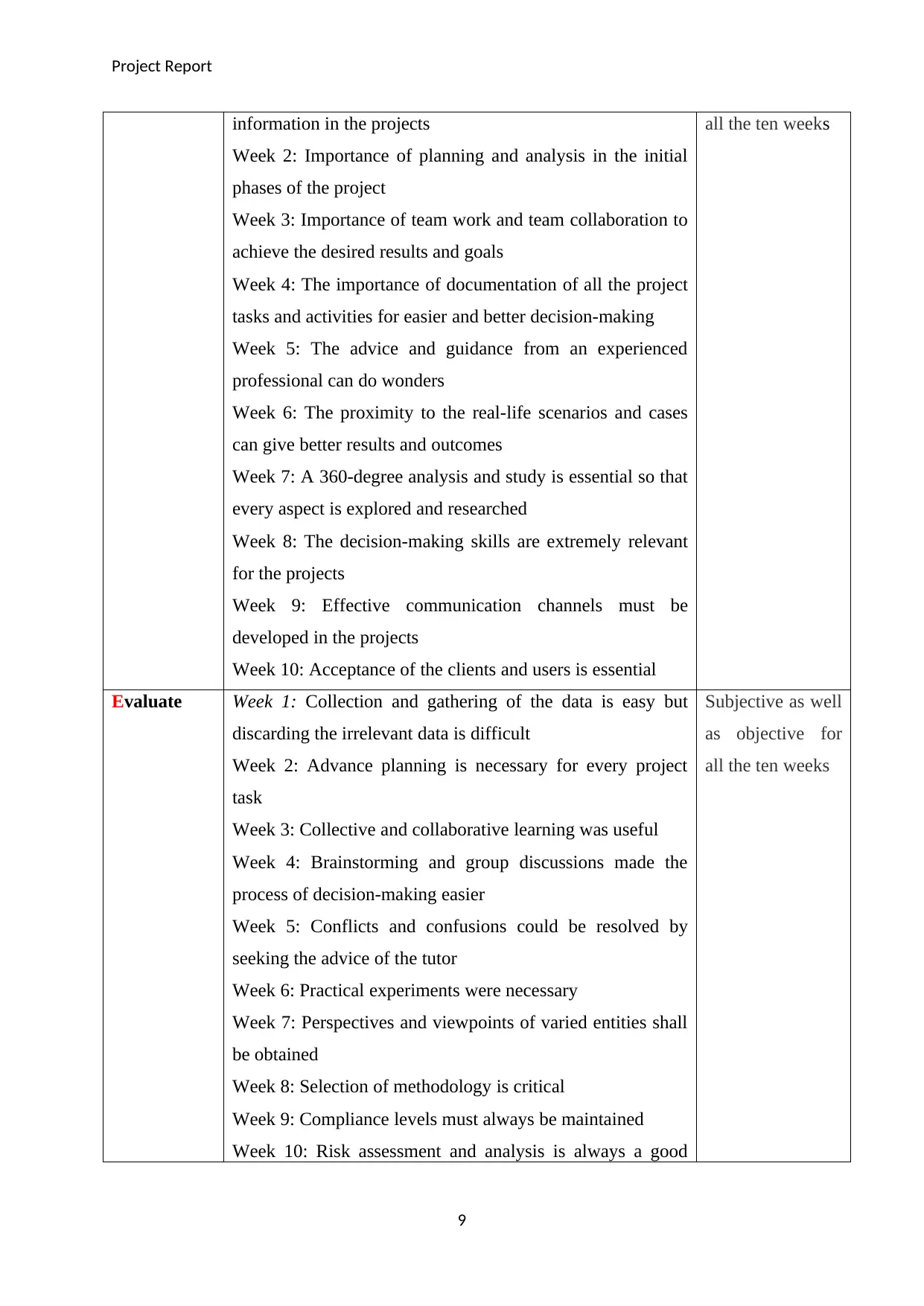
Project Report
information in the projects
Week 2: Importance of planning and analysis in the initial
phases of the project
Week 3: Importance of team work and team collaboration to
achieve the desired results and goals
Week 4: The importance of documentation of all the project
tasks and activities for easier and better decision-making
Week 5: The advice and guidance from an experienced
professional can do wonders
Week 6: The proximity to the real-life scenarios and cases
can give better results and outcomes
Week 7: A 360-degree analysis and study is essential so that
every aspect is explored and researched
Week 8: The decision-making skills are extremely relevant
for the projects
Week 9: Effective communication channels must be
developed in the projects
Week 10: Acceptance of the clients and users is essential
all the ten weeks
Evaluate Week 1: Collection and gathering of the data is easy but
discarding the irrelevant data is difficult
Week 2: Advance planning is necessary for every project
task
Week 3: Collective and collaborative learning was useful
Week 4: Brainstorming and group discussions made the
process of decision-making easier
Week 5: Conflicts and confusions could be resolved by
seeking the advice of the tutor
Week 6: Practical experiments were necessary
Week 7: Perspectives and viewpoints of varied entities shall
be obtained
Week 8: Selection of methodology is critical
Week 9: Compliance levels must always be maintained
Week 10: Risk assessment and analysis is always a good
Subjective as well
as objective for
all the ten weeks
9
information in the projects
Week 2: Importance of planning and analysis in the initial
phases of the project
Week 3: Importance of team work and team collaboration to
achieve the desired results and goals
Week 4: The importance of documentation of all the project
tasks and activities for easier and better decision-making
Week 5: The advice and guidance from an experienced
professional can do wonders
Week 6: The proximity to the real-life scenarios and cases
can give better results and outcomes
Week 7: A 360-degree analysis and study is essential so that
every aspect is explored and researched
Week 8: The decision-making skills are extremely relevant
for the projects
Week 9: Effective communication channels must be
developed in the projects
Week 10: Acceptance of the clients and users is essential
all the ten weeks
Evaluate Week 1: Collection and gathering of the data is easy but
discarding the irrelevant data is difficult
Week 2: Advance planning is necessary for every project
task
Week 3: Collective and collaborative learning was useful
Week 4: Brainstorming and group discussions made the
process of decision-making easier
Week 5: Conflicts and confusions could be resolved by
seeking the advice of the tutor
Week 6: Practical experiments were necessary
Week 7: Perspectives and viewpoints of varied entities shall
be obtained
Week 8: Selection of methodology is critical
Week 9: Compliance levels must always be maintained
Week 10: Risk assessment and analysis is always a good
Subjective as well
as objective for
all the ten weeks
9
Paraphrase This Document
Need a fresh take? Get an instant paraphrase of this document with our AI Paraphraser
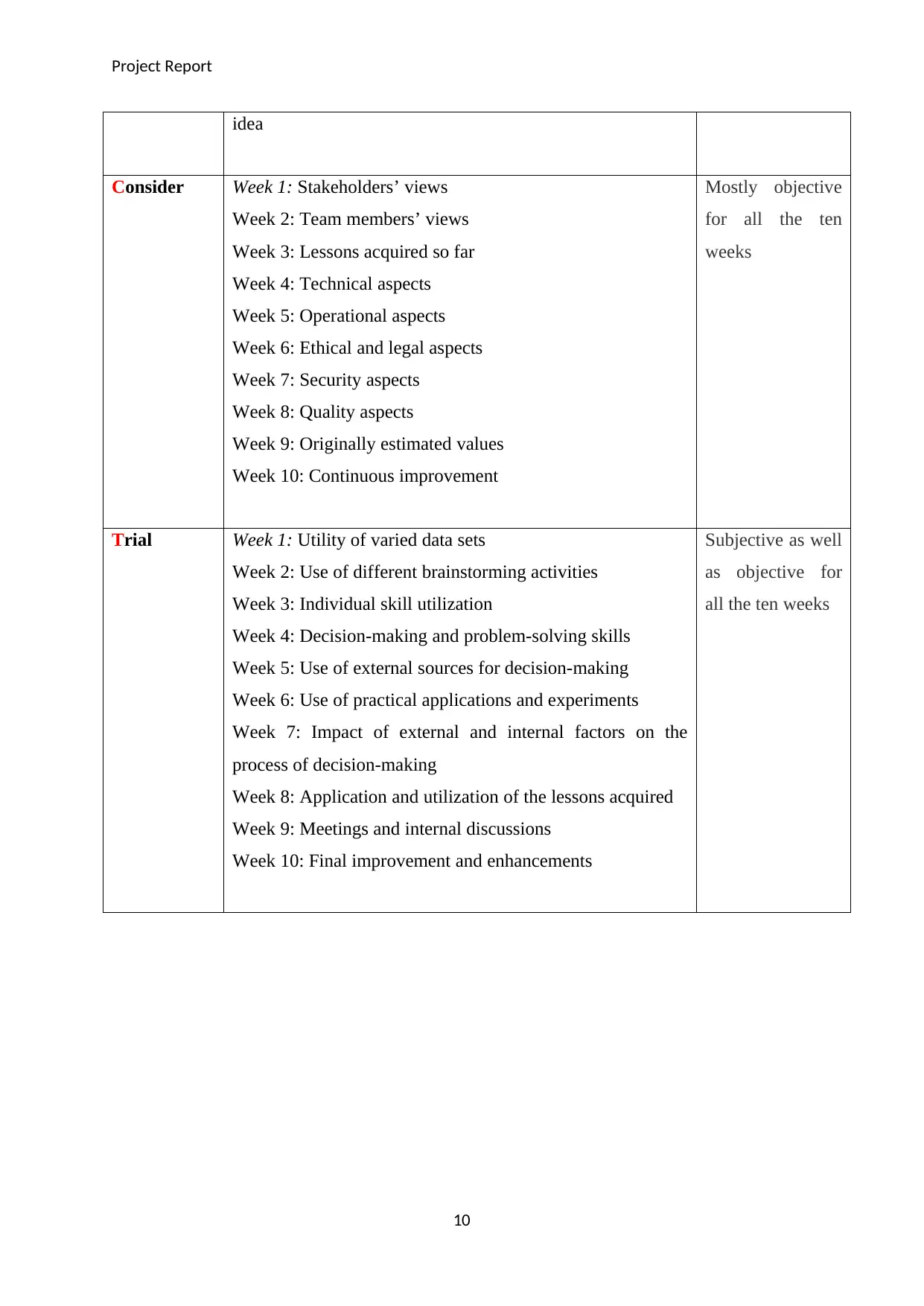
Project Report
idea
Consider Week 1: Stakeholders’ views
Week 2: Team members’ views
Week 3: Lessons acquired so far
Week 4: Technical aspects
Week 5: Operational aspects
Week 6: Ethical and legal aspects
Week 7: Security aspects
Week 8: Quality aspects
Week 9: Originally estimated values
Week 10: Continuous improvement
Mostly objective
for all the ten
weeks
Trial Week 1: Utility of varied data sets
Week 2: Use of different brainstorming activities
Week 3: Individual skill utilization
Week 4: Decision-making and problem-solving skills
Week 5: Use of external sources for decision-making
Week 6: Use of practical applications and experiments
Week 7: Impact of external and internal factors on the
process of decision-making
Week 8: Application and utilization of the lessons acquired
Week 9: Meetings and internal discussions
Week 10: Final improvement and enhancements
Subjective as well
as objective for
all the ten weeks
10
idea
Consider Week 1: Stakeholders’ views
Week 2: Team members’ views
Week 3: Lessons acquired so far
Week 4: Technical aspects
Week 5: Operational aspects
Week 6: Ethical and legal aspects
Week 7: Security aspects
Week 8: Quality aspects
Week 9: Originally estimated values
Week 10: Continuous improvement
Mostly objective
for all the ten
weeks
Trial Week 1: Utility of varied data sets
Week 2: Use of different brainstorming activities
Week 3: Individual skill utilization
Week 4: Decision-making and problem-solving skills
Week 5: Use of external sources for decision-making
Week 6: Use of practical applications and experiments
Week 7: Impact of external and internal factors on the
process of decision-making
Week 8: Application and utilization of the lessons acquired
Week 9: Meetings and internal discussions
Week 10: Final improvement and enhancements
Subjective as well
as objective for
all the ten weeks
10
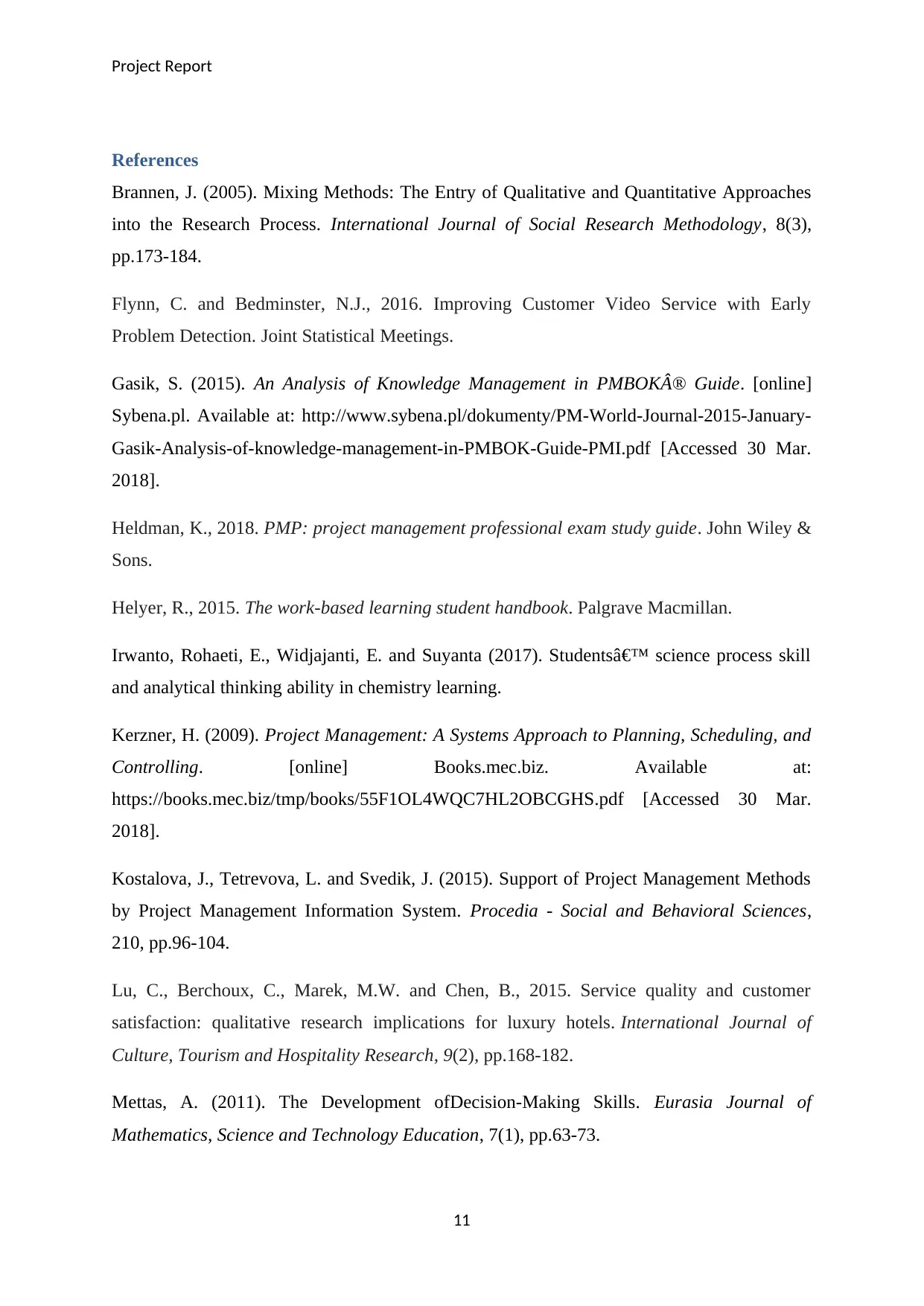
Project Report
References
Brannen, J. (2005). Mixing Methods: The Entry of Qualitative and Quantitative Approaches
into the Research Process. International Journal of Social Research Methodology, 8(3),
pp.173-184.
Flynn, C. and Bedminster, N.J., 2016. Improving Customer Video Service with Early
Problem Detection. Joint Statistical Meetings.
Gasik, S. (2015). An Analysis of Knowledge Management in PMBOK® Guide. [online]
Sybena.pl. Available at: http://www.sybena.pl/dokumenty/PM-World-Journal-2015-January-
Gasik-Analysis-of-knowledge-management-in-PMBOK-Guide-PMI.pdf [Accessed 30 Mar.
2018].
Heldman, K., 2018. PMP: project management professional exam study guide. John Wiley &
Sons.
Helyer, R., 2015. The work-based learning student handbook. Palgrave Macmillan.
Irwanto, Rohaeti, E., Widjajanti, E. and Suyanta (2017). Students’ science process skill
and analytical thinking ability in chemistry learning.
Kerzner, H. (2009). Project Management: A Systems Approach to Planning, Scheduling, and
Controlling. [online] Books.mec.biz. Available at:
https://books.mec.biz/tmp/books/55F1OL4WQC7HL2OBCGHS.pdf [Accessed 30 Mar.
2018].
Kostalova, J., Tetrevova, L. and Svedik, J. (2015). Support of Project Management Methods
by Project Management Information System. Procedia - Social and Behavioral Sciences,
210, pp.96-104.
Lu, C., Berchoux, C., Marek, M.W. and Chen, B., 2015. Service quality and customer
satisfaction: qualitative research implications for luxury hotels. International Journal of
Culture, Tourism and Hospitality Research, 9(2), pp.168-182.
Mettas, A. (2011). The Development ofDecision-Making Skills. Eurasia Journal of
Mathematics, Science and Technology Education, 7(1), pp.63-73.
11
References
Brannen, J. (2005). Mixing Methods: The Entry of Qualitative and Quantitative Approaches
into the Research Process. International Journal of Social Research Methodology, 8(3),
pp.173-184.
Flynn, C. and Bedminster, N.J., 2016. Improving Customer Video Service with Early
Problem Detection. Joint Statistical Meetings.
Gasik, S. (2015). An Analysis of Knowledge Management in PMBOK® Guide. [online]
Sybena.pl. Available at: http://www.sybena.pl/dokumenty/PM-World-Journal-2015-January-
Gasik-Analysis-of-knowledge-management-in-PMBOK-Guide-PMI.pdf [Accessed 30 Mar.
2018].
Heldman, K., 2018. PMP: project management professional exam study guide. John Wiley &
Sons.
Helyer, R., 2015. The work-based learning student handbook. Palgrave Macmillan.
Irwanto, Rohaeti, E., Widjajanti, E. and Suyanta (2017). Students’ science process skill
and analytical thinking ability in chemistry learning.
Kerzner, H. (2009). Project Management: A Systems Approach to Planning, Scheduling, and
Controlling. [online] Books.mec.biz. Available at:
https://books.mec.biz/tmp/books/55F1OL4WQC7HL2OBCGHS.pdf [Accessed 30 Mar.
2018].
Kostalova, J., Tetrevova, L. and Svedik, J. (2015). Support of Project Management Methods
by Project Management Information System. Procedia - Social and Behavioral Sciences,
210, pp.96-104.
Lu, C., Berchoux, C., Marek, M.W. and Chen, B., 2015. Service quality and customer
satisfaction: qualitative research implications for luxury hotels. International Journal of
Culture, Tourism and Hospitality Research, 9(2), pp.168-182.
Mettas, A. (2011). The Development ofDecision-Making Skills. Eurasia Journal of
Mathematics, Science and Technology Education, 7(1), pp.63-73.
11
⊘ This is a preview!⊘
Do you want full access?
Subscribe today to unlock all pages.

Trusted by 1+ million students worldwide
1 out of 13
Related Documents
Your All-in-One AI-Powered Toolkit for Academic Success.
+13062052269
info@desklib.com
Available 24*7 on WhatsApp / Email
![[object Object]](/_next/static/media/star-bottom.7253800d.svg)
Unlock your academic potential
Copyright © 2020–2025 A2Z Services. All Rights Reserved. Developed and managed by ZUCOL.




